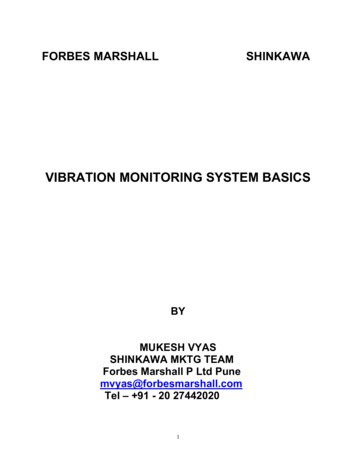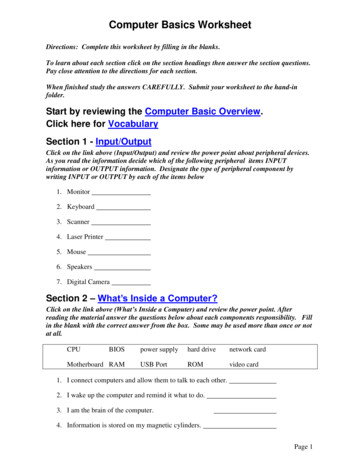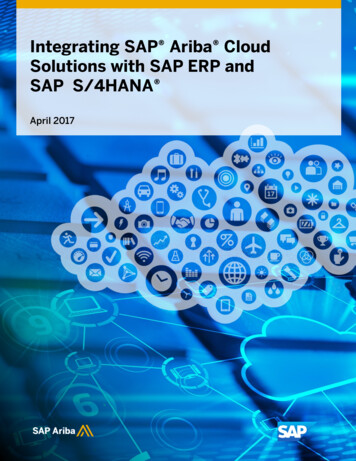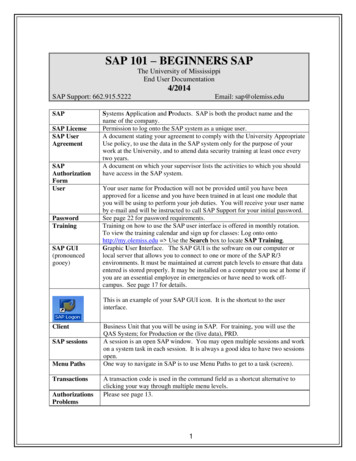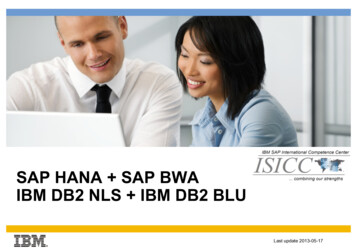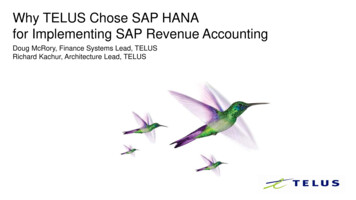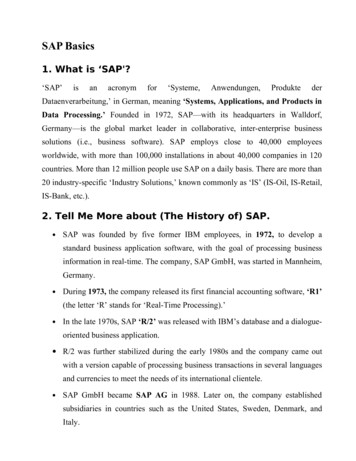
Transcription
SAP Basics1. What is gen,ProduktederDataenverarbeitung,’ in German, meaning ‘Systems, Applications, and Products inData Processing.’ Founded in 1972, SAP—with its headquarters in Walldorf,Germany—is the global market leader in collaborative, inter-enterprise businesssolutions (i.e., business software). SAP employs close to 40,000 employeesworldwide, with more than 100,000 installations in about 40,000 companies in 120countries. More than 12 million people use SAP on a daily basis. There are more than20 industry-specific ‘Industry Solutions,’ known commonly as ‘IS’ (IS-Oil, IS-Retail,IS-Bank, etc.).2. Tell Me More about (The History of) SAP. SAP was founded by five former IBM employees, in 1972, to develop astandard business application software, with the goal of processing businessinformation in real-time. The company, SAP GmbH, was started in Mannheim,Germany. During 1973, the company released its first financial accounting software, ‘R1’(the letter ‘R’ stands for ‘Real-Time Processing).’ In the late 1970s, SAP ‘R/2’ was released with IBM’s database and a dialogueoriented business application. R/2 was further stabilized during the early 1980s and the company came outwith a version capable of processing business transactions in several languagesand currencies to meet the needs of its international clientele. SAP GmbH became SAP AG in 1988. Later on, the company establishedsubsidiaries in countries such as the United States, Sweden, Denmark, andItaly.
The 1990s saw the introduction of SAP ‘R/3,’ with client-server architectureand GUI, which ran on almost any database, and on most operating systems.SAP R/3 heralded a new era in enterprise computing, moving from a ‘mainframe’ to a 3-tier architecture (Database- Application- User interface), whichbecame the new industry standard. By 1996, the company had more than 9,000 installations worldwide. By theend of the 1990s, SAP had introduced the e-commerce enabled my SAP suiteof products for leveraging ever-expanding web technology. SAP began the twenty-first century with the Enterprise Portal and role-basedaccess to business information. SAP continues to evolve and innovate, bringing cutting-edge technologies tobusiness-information processing. SAP has already introduced SAP NetWeaver, which is based on Enterprise Services Architecture (ESS) withapplication integration across diverse platforms for providing one-stop end-toend business processing. With Net Weaver, companies can now integratepeople, information, and processes.3. What are the ‘Solutions’ Currently Available from SAP?Currently, SAP Solutions include the following: SAP ERP SAP SAP Business Suite SAP R/3 and R/3 Enterprise SAP for Industries SAP xApps SAP Solution Manager
4. What are the Components of the ‘SAP ERP’ Solution? SAP ERP Central Component (ECC 6.0) SAP SEM (Strategic Enterprise Management) (SEM 6.0) SAP cProject Suite (Project and Portfolio Management 4.0) SAP SRM for ERP (SRM 5.0) SAP Catalog Content Management (CCM 2.0 for ERP 2004) SAP Internet Sales for latform?The SAP ‘NetWeaver’ platform allows organizations to build new business solutionsrapidly while realizing more business value from existing IT investments. SAPNetWeaver supports new cross-functional business processes and helps to lower theTotal Cost of Ownership (TCO) by reducing the need for custom integration. Itoffers complete life cycle management for all of your applications. It is also thefoundation for Enterprise Services Architecture (EAS) and helps align people,information, and business processes across organizational and technologicalboundaries.6. What are the Components of ‘NetWeaver’?By providing an open integration and application platform and permitting theintegration of the Enterprise Services Architecture, SAP NetWeaver helps unifybusiness processes across technological boundaries, integrating applications foremployees as needed, and accessing/editing simple information easily in a structuredmanner.Components include: Security
People Integration Multi-channel Access Portal Collaboration Information Integration Business Intelligence BI (Business Intelligence) Content Knowledge Management Master Data Management Process Integration Integration Broker Business Process Management Application Platform Java ABAP Business Services Connectivity DB and OS Abstraction SAP Knowledge Warehouse Life Cycle Management Customizing Software Change Management System Management
7. What are the Components of the ‘SAP Business Suite’? SAP Customer Relationship Management (CRM 5.0) SAP Supply Chain Management (SCM 5.0) SAP Supplier Relationship Management (SRM) SAP SRM 2007 SAP Catalog Content Management (SRM-MDM 1.0) SAP Product Life Cycle Management SAP Product Life Cycle Management 4.00 SAP Environment, Health, and Safety 2.7B SAP PLM Recipe Management 2.1 Audit Management SAP Compliance Management for SOA Management of Internal controls 1.0 SAP Learning Solution 2.00 SAP Strategic Enterprise Management (SEM)8. What are the Most Recent Releases of the ‘SAP R/3'Solution? SAP R/3 Enterprise Release 4.70 SAP R/3 Release 4.6C/4.6B/4.5B/4.0B9. What ‘Industry Solutions’ (IS) are Available from SAP?There are 22 Industry Solutions available from SAP. They are: SAP for Aerospace and Defense SAP for Automotive
SAP for Banking SAP for Consumer Products SAP Contract Accounts Receivable and Payable SAP for Defense and Security SAP for Engineering, Construction and Operations SAP for Financial Service Providers SAP for Healthcare SAP for Higher Education and Research SAP for High Tech SAP for Insurance SAP for Media SAP for Mill Products SAP for Mining SAP for Oil and Gas SAP for Professional Services SAP for Public Sectors SAP for Retail SAP for Telecommunications SAP for Utilities SAP for Wholesale Distribution10. What is ‘SAP xApps’?The ‘SAP xApps’ family of composite applications enables continuous businessinnovation—and provides the flexibility necessary to respond quickly and profitablyto business changes. They extend the value of core business investments and
maximize the return on strategic assets: employees, knowledge, products, businessrelationships, and IT.SAP and SAP certified partners deliver these composite applications that drivespecialized business processes, provide comprehensive business insights, and focuson the needs of a variety of industries.All these applications combine Web services and data from multiple systems in anapplication design made possible by the SAP Composite Application Frameworkwithin the SAP NetWeaver technology platform. This framework includes themethodology, tools, and run-time environment to develop composite applications. Itprovides a consistent object model and a rich user experience, and gives developers aproductive way to create composite applications on top of a set of heterogeneousapplications.11. What are all the Components of ‘SAP xApps’? Duet SAP Document Builder SAP Global Trade Services SAP xApp Manufacturing Integration and Intelligence SAP xApp Resource and Portfolio Management SAP xApp Product Definition SAP xApp Cost and Quotation Management SAP xApp Integrated Exploration and Production SAP xApp Sales and Operations Planning12. What is known as ‘Duet’?A component under SAP xApps, ‘Duet’ is a first-of-its-kind software solution fromSAP and Microsoft that enables users to easily and quickly interact with SAP
business processes and data via their familiar Microsoft Office environment. Theresult of a groundbreaking collaboration between SAP and Microsoft, it is the firstjoint product created by these two industry leaders and is designed to revolutionizehow IT workers interact with enterprise applications.Duet enables: Budget Monitoring: Schedule time-critical alerts and notifications to monitorcost centers or internal orders, which are delivered directly to MicrosoftOutlook. Demand Planning: Create and use planning sheets, as well as analyze andmanage demand planning data from the SAP System using Microsoft Excel. Duet Reporting: Schedule reports to be delivered regularly to MicrosoftOutlook, receive individual reports on an as-needed basis, and view reports inMicrosoft Excel. Leave Management: Add leave requests as Microsoft Outlook calendar itemsthat integrate approval guidelines in the SAP System and enterprise-definedprocesses. Sales Management: Manage CRM accounts and contacts, create businessactivities, and access sales analytics information using Microsoft Outlook. Team Management: Access up-to-date information about yourself andemployees, open positions, and organizational structures that are integratedfrom the SAP System into the Microsoft Outlook contacts area. Time Management: Record time in the Microsoft Outlook calendar,streamlining time entry while ensuring time-reporting compliance in the SAPSystem. Travel Management: Create a travel request and a travel expense report in theSAP System using Microsoft Outlook.
13. Explain the ‘SAP Document Builder.’‘SAP Document Builder’ (CA-GTF-DOB) is a content-driven and cross-applicationsolution for building and authoring complex documents. As a generic tool, it can bedeployed within international organizations and large corporations to generatecontract and bid invitation documents, banking-related documents, auto insurancepolicies, real estate contracts, and corporate employment policies.You can deploy SAP Document Builder as a standalone application or integrate itwith other SAP or non-SAP components. For example, you can generate businessdocuments required in a procurement system and store them in an electronic datastorage system.The SAP Document Builder supports you by: Automating and streamlining the document-creation process. Enforcing best practices. Building documents that reflect company-specific styles and formats from oneor more regulation sets. Determining inclusion or exclusion of clauses based on legal regulations bymeans of rules.14. Explain the ‘SAP Solution Manager.’Providing central access to Tools, Methods, and Pre-Configured Content, the SAPSolution Manager provides support throughout the life cycle of solutions—fromBusiness Blueprint to Configuration to Support.The features include: Implementation/Upgrade of SAP Solutions Central access to Project Tools (Project Administration, BusinessBlueprint, Configuration, Test Workbench, Group Rollout Templates)
Central management of Project Information (Roadmap, SystemLandscape, Documentation, etc.) SAPcomponents Solution Monitoring Central System Administration System Landscape Analysis with System Level Reporting Real-time System Monitoring Business Process Monitoring Services and Support Access to programs/services for monitoring and optimizing systemperformance and availability to minimize risks. Service Desk Solution Support through Work Flow to create and manageProcess/Problem Messages. Change Management Trace and audit system changes and transports through Change RequestManagement.
Figure 1: SAP Solution Manager15. Explain how ‘mySAP ERP Financial’ is Better/Differentthan ‘R/3 Financial Accounting.’‘mySAP ERP Financials’ is built on the NetWeaver platform, which is thefoundation for service-oriented business solutions, for deploying financial processesat a faster pace. Irrespective of the business type, mySAP ERP Financials is designedto support financial accounting requirements to provide a single complete platform toachieve excellence in accounting, performance management, financial supply chain,and corporate governance. The features include: Industry-Specific Financial ManagementMy SAP ERP Financials provides a comprehensive and robust analyticalframework to consolidate and/or dissect business information generated inindustry solutions or core enterprise processes: all managers in all operationshave an improved visibility with a single integrated solution.
Performance ManagementMy SAP ERP Financials provides a single solution for the entire life cycle ofCorporate Performance Management by delivering real-time, personalizedmeasurements and metrics to improve business insight and productivity ofnon-technical users. Executives, managers, and business workers will nowhave access to information such as business statistics and Key PerformanceIndicators (KPI) presented in the context of business tasks for better insightand faster decision making. mySAP ERP Financials encompasses: Consolidated financial and statutory reporting Planning, budgeting, and forecasting Strategy management and scorecards Risk management Financial analytics Financial and Management AccountingMy SAP ERP Financials helps companies comply with global accountingstandards (such as the United States’ Generally Accepted AccountingPrinciples (GAAP) and the International Financial Reporting Standards(IFRS). With the ‘New FI-GL’ functionality (Refer to Q.181 for more details)you will now have the ability to generate financial statements of any dimensionof the business (unit, profit center, geographical location, etc.). This offersgreater flexibility to extend a chart of accounts and allows an easier method ofreporting by individual management units and segments. This feature helpscompanies reduce the complexity and costs associated with parallel accountingor managing a set of books by region, industry, or regulatory reporting statute.
Corporate GovernanceWith a set of applications and tools, my SAP ERP Financials assists in meetingthe specific requirements of today’s financial regulations such as theSarbanesOxley Act. You now have an intuitive mechanism to collect,document, assess, remediate, and attest to internal control processes andsafeguards to ensure transparent business activity. By configuring controls anddefining rules and tolerances for your
SAP Basics 1. What is ‘SAP'? ‘SAP’ is an acronym for ‘Systeme, Anwendungen, Produkte der Dataenverarbeitung,’ in German, meaning ‘Systems, Applications, and Products in Data Processing.’ Founded in 1972, SAP—with its headquarters in Walldorf, Germany—is the global market leader in collaborative, inter-enterprise business



